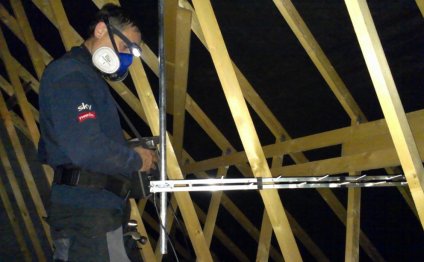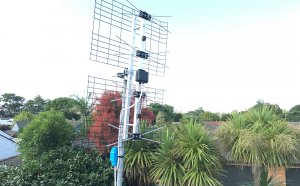
Loft Aerial Installation
There are only three issues need to understand siting aerials -
- Height things. The bigger, the higher. Rooftop is better than loft, loft is better than set-top. Use landscapes and you may fairly effortlessly see why. What that doesn't explain to you is all of the clutter shielding your aerial from line of web site is near to you - neighbouring houses, woods and stuff. More level gets you above it-all.
- playing an extended 2nd fiddle to level, generally the more steel you've got into the sky the higher. 18 elements is normally much better than 14 - but another three feet in height is more preferable in many urban situations!
- Utilize decent cable for digital. It has little related to loss and every little thing regarding keeping undesired interference causing occasional image freezes. In the event that you have to use 15 yr old brown coax after that put your aerial 20 feet greater :-) really, only cannot get it done. Here is why.
So, here is the cast of figures you need to use for DTT.
if you would like see how to, or carry on for order that people with increased passion than comprehending frequently decide to try...
the nice
Tape and Braid screened cable (CT00, WF100 and stuff like that)
Use no other cable anywhere in the RF course of one's system amongst the aerial, various other components together with TV. Listed here is the reason why.
Loft aerial £20
If you're in an excellent service area, generally speaking within 10-15 kilometers associated with the transmitter, this is a good option for analogue television. If you're in a cul-de-sac and do not mind the odd frost when some kid goes last on an affordable motorbike, you may get away with this for DTT. If for example the aerial is near a primary road you may possibly have issues on electronic. For a £20 investment you are able to draw it and discover - its your biggest chance for a DIY win, and you can take a dry run if you take the downlead through loft hatch and along the stairs on a temporary foundation.
The problem is that the aerial is close to countless resources of impulse disturbance - light switches, mains wiring inside loft holding mains-borne hash, central heating pumps going down. Not one among these sources is specially powerful, but their influence falls away with the square of the length towards aerial. In a typical loft the mains wiring is two feet from the aerial. Place that on your roofing and it's ten feet from aerial - and so the interference may be 25 times weaker plus your signal may well be more than doubled (you drop about 6dB assessed on television input through an average tile roof ). That is a 50:1 improvement to impulse sound resistance!
When buying an aerial the loft, the most obvious urge is to get the largest and greatest you'll, appropriate? Never. A 14-element is sufficient. High quality however matters - get a CAI benchmarked aerial as DTT aerials actually ought to be balanced to reduce impulse disturbance. The grading is
- Traditional 1 Should supply adequate DTT reception also for domiciles from the fringes of coverage areas
- Standard 2 Intermediate standard, ideal for use within the coverage
- Traditional 3 Minimum standard required for good protection problems
- Traditional 4 approved where much better wideband overall performance is needed.
You are in the 2 or 3 mark. Don't also think about making use of a regular 1 in a loft- it is huge and don't work immediately. You don't need to tangle with aerial grouping while you're perhaps not performing an analogue install - the CAI benchmarking will look after performance dilemmas for you. If you have a definite line of picture and are also within 8 kilometers of this transmitter a 3 will see you ok, else utilize a 2 - supplied you have a definite line of sight.
When it isn't good enough within the loft put the exact same aerial outside - a larger aerial is unlikely working inside the loft. Could, needless to say, use decent cable and line your aerial plugs precisely.
Why you mustn't you will need to make use of a big aerial indoors is that an aerial is made to work because of the interaction between the conductive elements, and clearly, for a large aerial there is a large number of these. The aerial is made assuming it is mounted on the roofing with environment area all-around. That is not the case in your loft - there's all sorts of bits of metal and often a great big water tank through which you definitely do not want the aerial pointing.
Typical loft aerial in 3 bed home- red may be the mains burning circuit (supply of impulse interference) and blue could be the liquid system.
The metalwork associated with water system and mains wiring may also become conductive elements, and will usually act to detune your aerial and degrade its overall performance. Eliminate metalwork at the aerial. If at all possible stay away from any steel or wiring nearer to it than its length besides behind the aerial in which it mustn't be a problem, and a vertical airplane through the growth for a horizontally polarised aerial. in which furthermore not especially sensitive to detuning (this will be typically where the aerial pole is installed in a rooftop scenario).
This all gets more difficult to-do while the aerial gets bigger, and also the effect of spurious surrounding metalwork is even worse on a more impressive aerial which relies on the discussion of more elements. I came across an Antiference Xtragain XG16 WB lost 7dB gain on networks 44-52 when attached halfway in the loft, weighed against equivalent aerial from the gable wall surface outside during the same level. This really is an aerial over 2m lengthy as well as its overall performance had been paid off to less than that of the much cheaper XG5W at a third the dimensions! It is not a reflection on Antiference's product - its a comment back at my abuse of it!
benefits:
Easy Do-it-yourself.
effective in a lot of circumstances particularly analogue installments.
Weather doesn't enter the aerial.
Loft is an excellent location if you are likely to utilize a distribution system.
disadvantages:
DTT is specially susceptible to impulse disturbance here.
Doesn't work on some forms of roof insulation with metallic foils.
Low aerial level implies less signal strength than in the open air.
Roof quickly halves your signal power, more when wet.
Aerial takes up lots of loft and gratification can differ if items tend to be added/moved in loft.
External aerial £140, can be less DIY if things work right first time
It’s this that the broadcasters created the device for. If you get a CAI specialist to do this work then you don't have to be worried about technology - simply specify which networks you prefer and he will choose the parts to supply that for you. If you are going to get this done yourself then you might besides steer clear of the cheapest aerials which never last in the British weather condition - get a CAI benchmarked one so that you understand it at the least executes okay. Use good cable. And think of how-to stop water stepping into the aerial connections and cable.
Your absolute best shot. If this won't work, absolutely nothing else will.
difficult/higher in advance price, though when you've added collectively everything required for a Do-it-yourself task the specialist method doesn't look therefore pricey for a guaranteed win...
weather condition degradation - a patio aerial should simply be anticipated to have a 10 12 months service life in britain.
Share this Post
Related posts
UHF Aerial Installation
Brand new UHF Aerial Installation from Kiwi Antennas expense basically $245 for hockey stick eave mount and attic mount installation…
Read MoreAerial Installation
Janet Echelman is setting up her brand-new sculpture these days. Not in a gallery or on a pedestal, but instead soaring throughout…
Read More










